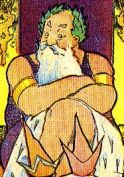Any time animation history is discussed, Winsor McCay will always be mentioned. And although it wasn't his first film, it's "Gertie the Dinosaur" that will be noted. This is due to the fact that for the first time audiences were seeing a real animated character, a real personality. Winsor McCay realized you could use film to do something New -- you could go beyond simple animated gimmicks that had already been seen in flipbooks for years -- you could use film to tell stories, to bring characters to life.
When talking about the chronology of animation history, the two names that get mentioned before McCay are J Stewart Blackton and Emile Cohl. I thought I would provide movies from all three filmakers here in one spot so you can see the progression -- and the HUGE leap between McCay's accomplishment and the few experiments that proceeded him.
First up is Blackton. He was an American artist and, like McCay, created his first film as a variation on his vaudeville speed-drawing act. "Humorous Phases of Funny Faces" was created in 1906 and is considered to be the first animated film. That is, it's on film and the pictures move. This was accomplished by drawing pictures on a blackboard, shooting a frame of film, then erasing and redrawing parts of the picture:
The next name that gets mentioned is Emile Cohl. This French artist created "Fantasmagorie" in 1908. This is considered to be the first example of "traditional hand drawn animation" because it was drawn on successive sheets of paper. It was shot on negative film however to make it look like white line on blackboard:
Then comes Winsor McCay. After now having seen what came before him, I hope appreciation for what McCay accomplished is greatly magnified. His first film was in 1911, but I'm going to show Gertie (1914) because, again, this is the film that gets mentioned in animation history because it's the first character driven personality to appear in animation. Again, think of what came before, now look at what Winsor did:
I marvel at how detailed and fluid the movement is. In terms of animation, this is more beautiful than a lot of cartoons being produced today! Gertie looks so dimensional, she has such a sense of weight - she looks real. In fact, the reason McCay chose a dinosaur was to prove he wasn't somehow just tracing live action. Notice how all those animation techniques taught today -- slow ins and outs, use of arcs, secondary actions, etc -- those principles are all there! Before those techniques were ever articulated, McCay intuitively worked all that in. Also keep in mind that this was before cels. When animation later advanced, backgrounds were painted on a separate surface, and all the frames of animation were created on transparent cels so the background could show through from beneath. But McCay is inventing all this from scratch, and no one has ever considered cels yet. That complicated background had to be redrawn by hand on every single frame --- drawn over and over thousand and thousands of times! "Gertie the Dinosaur" is a marvelous feat.
I think it depends on what your definition of animation is. If animation is simply "making something move," Blackton and Cohl did that. But if animation is "bringing something to life," McCay is first in my book.
Tuesday, November 20, 2007
Subscribe to:
Post Comments (Atom)

1 comment:
I just watched these with my kids. During "Gertie" my four year old said, "Oh! She's a bad girl!"
That's the great thing about McCay -- all these years later his characters still read perfectly, accessible to anyone. My daughter totally believed in Gertie.
Post a Comment